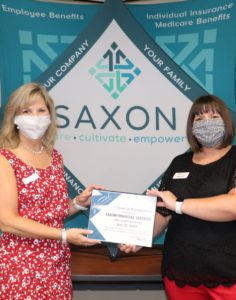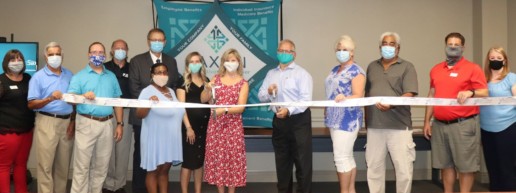Keeping Up with Professional Development During the Pandemic
As many state and local governments recommend and require social distancing, many professionals are looking at other ways to continue growing and developing. Read this blog post to learn more.
Many employees need to accumulate credits to keep their professional credentials, and they may look forward to large gatherings with their peers each year where they can learn about the latest developments in their industry. But the coronavirus pandemic is changing the way employees and businesses are approaching professional development, with many opting—at least for now—for online learning.
"We've seen a large shift in the manner in which these things are being done," said Melissa Peters, an attorney with Littler in Walnut Creek, Calif.
Since March 31, the U.S. State Department has advised U.S. citizens to avoid all international travel due to COVID-19. Within the U.S., the Centers for Disease Control and Prevention (CDC) had urged residents of New York, New Jersey and Connecticut to temporarily halt nonessential domestic travel and asked people everywhere in the country to carefully consider the risks before traveling.
"Some employers are going further and recommending that employees cancel or postpone all nonessential travel," observed Douglas Brayley, an attorney with Ropes & Gray in Boston.
The White House and many state and local governments have either recommended or required people to practice social distancing through April and even beyond—which is causing some business and professional associations to find creative alternatives to their in-person meetings.
Going Virtual
A webinar or videoconference may be a good alternative to an in-person meeting, Brayley said.
Elizabeth Wylie, an attorney with Snell & Wilmer in Denver, noted, "Many companies are bolstering their remote conferencing access to ensure it is adequate to meet the anticipated increase in needs in the coming weeks."
Kathleen Sullivan, chief human resources officer at law firm Clark Hill in Pittsburgh, said her firm is using webinars, videoconferencing and phone conferencing technologies. "Our goal is to continue to provide excellent client service while we ensure we are taking care of our employees," she said.
In response to limits on travel and social gatherings, some licensing bodies have eased up on their e-learning limits. For instance, the Indiana Supreme Court and other state high courts have temporarily waived distance-learning limitations for attorneys seeking continuing education credits.
The Society for Human Resource Management (SHRM) has transformed its 2020 Talent Conference & Exposition to a virtual experience so attendees can stay current and earn professional development credits without leaving their homes.
"We've been working with public health officials and collaborating with the conference venue and vendors to make an informed decision based on the latest science, local public health guidance, and our ability to provide the HR community with the best event and professional development experience you've come to expect from SHRM, in a safe environment," SHRM said on its website.
Should Employers Reimburse Nonrefundable Expenses?
"There is not a uniform practice in terms of [employers] reimbursing for canceled or postponed trips," said Mark Keenan, an attorney with Barnes & Thornburg in Atlanta. He said organizations need to make such decisions based on:
- The health and welfare of their employees.
- Whether such trips can be rescheduled or postponed with limited incidental additional expense.
"However," Keenan said, "most organizations would still reimburse such trips as an appropriate business expense, and therefore should reimburse nonrefundable costs as they would with any other itinerary change."
If the employer paid for the professional development and travel in the first place, any cancellation costs would generally be absorbed by the employer, said Susan Kline, an attorney with Faegre Drinker in Indianapolis. "If it's something the employee signed up for as a personal matter for a weekend or vacation, employers might treat it like any other vacation."
She noted that some states, such as California, require employers to reimburse reasonable business expenses.
Peters said employers are making difficult business decisions as they struggle with the economic impact of COVID-19. "There are legal aspects, but whether or not you want to reimburse people for professional development should be aligned with the company's philosophy and business needs."
The best practice for each business is highly dependent upon its business needs, industry and workforce, Wylie said, and is subject to change as the recommendations of public health agencies evolve.
Stay Updated
"The employer community seems to be very proactive in communicating updates on the coronavirus and the impact on their workforces," Keenan observed. For now, he said, the best practices are to not panic and to monitor the CDC's website.
"The situation is evolving rapidly," Sullivan said. "It is important to stay up-to-date with the current information."
SOURCE: Nagele-Piazza, L. (13 April 2020) "Keeping Up with Professional Development During the Pandemic" (Web Blog Post). Retrieved from https://www.shrm.org/resourcesandtools/legal-and-compliance/employment-law/pages/keeping-up-with-professional-development-during-the-pandemic.aspx
What to Do When Scared Workers Don’t Report to Work Due to COVID-19
Throughout the globe, many are terrified of contracting the communicable disease, the coronavirus. With this being said, many essential workers are refusing to go to work with that fear in their minds. Read this blog post from SHRM to learn more.
Some essential workers are refusing to come to work out of fear of contracting the coronavirus. Their employers must weigh the employees' legal rights and understandable health concerns with the organizations' business needs. It can be a tough balancing act.
"A good first step for an employer to respond to an essential worker who's expressing fears of returning to work is to actively listen to the employee and have a conversation," said Brian McGinnis, an attorney with Fox Rothschild in Philadelphia. "What are their specific concerns? Are they reasonable?"
McGinnis said that employers should consider whether it already has addressed those concerns or if additional steps are needed. Often, having a conversation with the employee "will avoid an unneeded escalation," he said.
Employees' Legal Rights
What if that doesn't work? Tread cautiously, as employees have many legal protections.
An employer usually can discipline workers for violating its attendance policy. But there are exceptions to that rule, noted Robin Samuel, an attorney with Baker McKenzie in Los Angeles. Putting hesitant employees on leave may be a better choice than firing them.
Christine Snyder, an attorney with Tucker Ellis in Cleveland, cautioned, "If an employer permits employees to use vacation or PTO [paid time off] for leave, it may soon find itself without a workforce sufficient to maintain operations. Therefore, an employer may want to rely upon the terms of its existing time-off policy, which typically requires approval to use vacation or PTO, to require that leave for this reason be unpaid."
OSH Act
Employees can refuse to work if they reasonably believe they are in imminent danger, according to the Occupational Safety and Health (OSH) Act. They must have a reasonable belief that there is a threat of death or serious physical harm likely to occur immediately or within a short period for this protection to apply.
Samuel explained that an employee can refuse to come to work if:
- The employee has a specific fear of infection that is based on fact—not just a generalized fear of contracting COVID-19 infection in the workplace.
- The employer cannot address the employee's specific fear in a manner designed to ensure a safe working environment.
NLRA
The National Labor Relations Act (NLRA) grants employees at unionized and nonunionized employers the right to join together to engage in protected concerted activity. Employees who assert such rights, including by joining together to refuse to work in unsafe conditions, are generally protected from discipline, Samuel noted.
"That said, the refusal must be reasonable and based on a good-faith belief that working conditions are unsafe," said Bret Cohen, an attorney with Nelson Mullins in Boston.
ADA
Employers should accommodate employees who request altered worksite arrangements, remote work or time off from work due to underlying medical conditions that may put them at greater risk from COVID-19, Samuel said.
The EEOC's guidance on COVID-19 and the Americans with Disabilities Act (ADA) notes that accommodations may include changes to the work environment to reduce contact with others, such as using Plexiglas separators or other barriers between workstations.
The Age Discrimination in Employment Act, unlike the ADA, does not have a reasonable-accommodation requirement, pointed out Isaac Mamaysky, an attorney with Potomac Law Group in New York City. Nonetheless, he "would encourage employers to be flexible in response to leave requests from vulnerable employees," such as older essential workers, as the right thing to do and to bolster employee relations.
FFCRA
If a health care provider advises an employee to self-quarantine because the employee is particularly vulnerable to COVID-19, the employee may be eligible for paid sick leave under the Families First Coronavirus Response Act (FFCRA), Cohen noted. The FFCRA applies to employers with fewer than 500 employees, and the quarantine must prevent the employee from working or teleworking.
FFCRA regulations permit employers to require documentation for paid sick leave, noted John Hargrove, an attorney with Bradley in Birmingham, Ala.
Employers may relax documentation requirements due to the difficulty some employees could have obtaining access to medical providers during the pandemic and to encourage ill employees to stay away from work, said Pankit Doshi, an attorney with McDermott Will & Emery in San Francisco.
Hazard Pay
Although not currently mandated by federal law, hazard pay—extra pay for doing dangerous work—might be appropriate for an employer to offer to essential workers, McGinnis said.
If hazard pay is offered, similarly situated employees should be treated the same, he said. Otherwise, the employer risks facing a discrimination claim.
Andrew Turnbull, an attorney with Morrison & Foerster in McLean, Va., noted that companies with multistate operations may have legitimate reasons for offering hazard pay to employees working at locations with a high risk of exposure and not where the risk is minimal.
Hazard pay might be a good choice for public-facing jobs, where employees may not be able to observe social distancing, said Román Hernández, an attorney with Troutman Sanders in Portland, Ore.
Some localities require hazard pay in some circumstances, Doshi noted. These localities include Augusta, Ga., Birmingham, Ala., and Kanawha County, W.Va.
Inform and Protect Workers
Lindsay Ryan, an attorney with Polsinelli in Los Angeles, said that employers should keep employees apprised of all measures the employer is taking to maintain a safe workplace, consistent with guidance from the U.S. Centers for Disease Control and Prevention (CDC), the Occupational Safety and Health Administration, and local health authorities.
If employers have the means to do so, they should screen employees each day by taking their temperatures and send workers who have fevers home, Snyder said. Alternatively, employers can require employees to take their own temperatures before reporting to work, she added.
"Finally, in light of recent CDC guidance regarding the use of cloth masks to prevent infection, employers should allow employees to wear masks in the workplace and consider providing employees with cloth masks if they are able to acquire them," she said.
Judge strikes down parts of DOL's emergency paid leave regs
Dive Brief:
- Several features of the U.S. Department of Labor (DOL)'s regulations implementing the paid-leave provisions of the Families First Coronavirus Response Act (FFCRA) exceeded the agency's authority under federal law, a federal judge has ruled (State of New York v. U.S. Department of Labor, et al., No. 20-CV-3020 (S.D.N.Y. Aug. 3, 2020)).
- Among the struck-down DOL regulations are: the final rule's work-availability requirement; its definition of "health care provider" for the purposes of excluding certain healthcare sector employees from emergency leave benefits; its requirement that an employee secure employer consent for intermittent FFCRA leave; and its requirement that documentation be provided by an employee before taking FFCRA leave.
- The federal judge permitted the outright ban on intermittent leave for certain qualifying reasons — specifically, intermittent leave based on qualifying conditions that correspond with an increased risk of infection — as well as the substance of the final rule's documentation requirement to stand. The court, the judge said, "sees no reason that the remainder of the Rule cannot operate as promulgated in the absence of the invalid provisions."
The ruling is an important one for the nation's first-ever federal paid leave law for private-sector workers. New York originally filed the suit in April following the release of DOL's FFCRA implementation guidance earlier in the month. Shortly before the lawsuit's filing, Congressional Democrats criticized DOL's final rule in a letter to Secretary of Labor Eugene Scalia that said the agency's guidance either deviated from the FFCRA's statute or did not have a basis in it.
Asked about the letter, a DOL spokesperson told HR Dive in April that the agency took "quick action to implement paid sick leave and expanded paid family and medical leave provides necessary support for America's workforce in uncertain times."
The federal judge said in the ruling that DOL faced "considerable pressure" in promulgating its final rule. "This extraordinary crisis has required public and private entities alike to act decisively and swiftly in the face of massive uncertainty, and often with grave consequence," the judge noted. "But as much as this moment calls for flexibility and ingenuity, it also calls for renewed attention to the guardrails of our government. Here, DOL jumped the rail."
Management-side attorneys expect the ruling to be appealed, Bloomberg Law reported. The decision applies nationally, creates uncertainty for employers who experienced pandemic-related shutdowns or reductions in force and requires healthcare employers to "re-examine whether they must provide paid leave" to certain employees, Sami Assad, partner at FordHarrison LLP and chair of the firm's Home Healthcare Practice Group, wrote in an article.
The FFCRA applies to U.S. employers with fewer than 500 employees, but those with fewer than 50 employees may be exempt from two of the law's paid-leave requirements. An authorized officer of the business must use a three-prong test to determine whether the employer may claim an exemption. Also, the IRS has published guidance detailing how small businesses can receive 100% reimbursement for paid leave pursuant to the FFCRA.
SOURCE: Golden, R. (04 August 2020) "Judge strikes down parts of DOL's emergency paid leave regs" (Web Blog Post). Retrieved from https://www.hrdive.com/news/new-york-judge-strikes-down-dol-emergency-paid-leave-reg/582856/
Benefits Consideration for Onboarding Furloughed and Laid Off Employees
As the COVID-19 pandemic continues to create obstacles for the workplace, many professionals are still having to continue with their day-to-day work lives which include having hard discussions with furloughed and laid-off employees. Read this blog post to learn helpful tips on re-enrolling employees into their benefits.
COVID-19 continues to throw us curveballs. While some states that were continuing on their path to recovery are having to backtrack, others have managed to temporarily halt the progression of COVID-19 and are proceeding as planned.
Amidst all this uncertainty, one thing is certain: human resource professionals continue to face overwhelming obstacles. Below, we outline issues that human resource professionals are likely to face as they onboard furloughed and laid-off employees.
Onboarding Furloughed Employees
HEALTH AND WELFARE PLANS
For employees enrolled in one or more employer sponsored health and welfare plans and receiving coverage during the furlough period:
- Payroll deductions for required employee contributions for the plan generally resume upon return from furlough, subject to any changes in employment status that may affect eligibility.
- To the extent repayment of employee contributions advanced during the furlough period is required, consider how to collect the employee contributions (e.g., through payroll deduction or otherwise), keeping in mind state law requirements related to payroll deductions.
- Consider the extent to which election changes may be made upon return from furlough.
For employees not enrolled in an employer-sponsored health and welfare plan during the furlough period (or enrolled in COBRA continuation coverage):
- Determine when eligibility for the plan resumes in accordance with plan terms (e.g., immediately or after a waiting period), subject to any impact on eligibility due to changes in employment status.
- Consider the process for enrolling employees and the extent to which election changes may be made upon return from furlough, including any HIPAA special enrollment rights.
In addition:
- Evaluate the impact of the furlough on employees' full-time status under the Affordable Care Act's (ACA's) lookback measurement period and stability period requirements.
- Evaluate the impact of return from furlough on participation in wellness program activities and eligibility for wellness program incentives.
- To the extent employees will have staggered work schedules, consider entitlement to benefits based on reduced hours (full time/part time) or new job requirements and whether any plan amendments are needed.
401(K) PLANS
Generally, employee and company contributions resume upon return from furlough; however, changes in job titles or positions may affect eligibility:
- Determine whether employee and company contributions will resume immediately upon return from furlough based on elections in place immediately before the furlough period or whether new elections will be required.
- Determine the extent to which legally required notices relating to plan participation must be provided.
- Address the treatment of loan repayments upon return from furlough.
- Determine the extent to which the period of furlough must be counted for purposes of plan eligibility, vesting and the right to allocation of contributions.
PENSION PLANS
- Consider whether changes in job titles or positions may affect eligibility for continued participation upon return from furlough.
- Review plan terms to determine the extent to which the period of furlough must be counted for purposes of plan eligibility, vesting and benefit accrual.
OTHER BENEFITS
- Consider the impact of return from furlough on any commuter benefits (parking and transit).
- Consider the impact of return from furlough on vacation and holiday accrual.
Onboarding Laid-Off Employees
HEALTH AND WELFARE PLANS
- Treat rehired employees who have been laid off as new hires who must complete new hire paperwork for health and welfare plan eligibility.
- Consider the impact of the termination of employment and rehire on the employee's status as a full-time employee under the ACA's lookback measurement period and stability period requirements.
QUALIFIED RETIREMENT PLANS
- Defer to plan terms and break-in-service rules for purposes of determining the impact of the layoff on plan eligibility, vesting and benefit accrual.
- Review plan terms and procedures for enrolling rehired employees in a 401(k) plan, including application of the plan's auto-enrollment feature, if any.
SOURCE: Pepper, T. (29 July 2020) "Benefits Consideration for Onboarding Furloughed and Laid Off Employees" (Web Blog Post). Retrieved from https://www.shrm.org/resourcesandtools/hr-topics/benefits/pages/benefits-consideration-for-onboarding-furloughed-and-laid-off-employees.aspx
COVID-19 at-home testing kits can make returning to work safer
As many begin to return to the workplace, both employers and employees are fearful of bringing the COVID-19 virus into the workplace. A company has produced an at-home testing kit for those returning to work. Read this blog post to learn more.
While access to wide-spread coronavirus testing is still a barrier for millions of Americans, computer software company Appian is partnering with Everlywell, a digital health company, to offer COVID-19 at-home testing kits for employees returning to the workplace.
“Everlywell was founded to give people access to high-quality lab tests that can be taken at home,” said Julia Cheek, founder and CEO of Everlywell. “We are proud to support Appian’s customers in providing FDA-authorized COVID-19 testing to help keep them safe.”
Since March, more than 50 million coronavirus tests have been reported to the CDC, of which 5 million were positive. But as states reopen their economies and infection rates increase, there are growing concerns about supply chain problems, according to Politico. Reopening has increased demand for testing, causing samples to pile up faster than labs can analyze them, which is lengthening turnaround times for results — complicating efforts to contain the virus.
Everlywell’s at-home lab tests seek to streamline the process of testing for their employer clients. The COVID-19 test will be integrated within the Appian Workforce Safety solution. Through the partnership, people using Appian’s return-to-site solutions will be able to request home delivery of Everlywell’s COVID-19 testing kit by taking a screening questionnaire based on CDC guidelines. Each test request will be reviewed by an independent physician from Everlywell’s third-party telehealth partner. Test results can be delivered to the test-taker’s mobile device in 24-48 hours after the sample arrives at an authorized lab.
The lab tests have received emergency use authorization from the Food and Drug Administration. The testing used by the company and its lab partners meet the FDA’s performance criteria for COVID-19 test accuracy, and telehealth consultations are included for those who test positive.
“How much you know as an organization is how much you can protect the members of your organization,” says Matt Calkins, CEO of Appian. “This is the fastest way to get information on infection. We've seen that high amounts of testing can help minimize COVID-19. Knowledge is power, so we're trying to get [employers] as much knowledge as possible, as quickly as possible, and provide them with another tool to keep their employees safe.”
As employers make their strategies for returning to work, workplace safety is of top concern. Antibody screening, thermal cameras and on-site nurses are all methods being considered to help employees stay safe. Digital health is playing a major role in helping employees self-report their risks, whether that be the employee taking the subway, or living with someone who’s immunosuppressed. It can also help employers scalably monitor and assess people's symptoms on a daily basis, ensuring that sick employees stay at home and quarantine. Workplace changes may also include desks and workstations being spread further apart, and stricter limitations on large meetings and gatherings in the office.
Appian’s platform helps employers centralize and automate all the key components needed for safe returns to work. Through the platform, employers can process health screenings, return-to-site authorizations, contact tracing, isolation processing, and now, COVID-19 testing.
“A lot of people would rather work with an employer who goes the extra mile, who’s willing to offer and pay for tests if necessary for their own employees, and to quickly deploy it, where there’s even a suspicion of transmission,” Calkins says. “It’s a responsible gesture and a serious signal that the employer cares about the health of their workforce, and employees are reassured that their colleagues are more likely to be healthy.”
SOURCE: Nedlund, E. (30 July 2020) "COVID-19 at-home testing kits can make returning to work safer" (Web Blog Post). Retrieved from https://www.employeebenefitadviser.com/news/covid-19-at-home-testing-kits-can-make-returning-to-work-safer
Why continuous listening is the key to a smooth transition back to work
Returning to the workplace during this time can be difficult for many, especially with employers who are being faced with the question of how to create and keep a safe and comfortable workplace scene. Read this blog post to learn more.
As states and businesses reopen in the U.S., many employers are faced with a difficult decision: Should their employees go back to the workplace? And if so, when? Amazon told their workers they likely wouldn’t return until October, while Google announced that their employees wouldn’t go back to the office until 2021. Twitter and Facebook decided most employees could work from home forever.
But once employers do make that decision, they’re then confronted with a more formidable one: How do they get their employees back in a way that is both safe and comfortable for everyone? In short, how do they successfully manage employee experience?
Most companies have coordinated COVID-19 task forces charged with making those decisions and helping their employees navigate the global pandemic. And whether they realize it or not, those task forces are broken down into two different functions: operational and experiential.
When COVID-19 first hit, the task forces had to deal with the operational challenge of moving massive workforces home overnight, and they worked to ensure employees had the equipment and software needed to function remotely. And soon after, many realized they also had another responsibility on their plate: employee mental wellbeing.
Leaders recognized they’d have to find new ways to keep their people sharp, productive, and happy. In fact, their employees’ experience with remote work was a central component in making that big operational move successful.
The same will happen as task forces bring people back to the workplace. In fact, managing employee experience will become a task force’s most critical responsibility. To ensure employees feel comfortable returning to the workplace, company leadership needs to know how they feel about coming back and what safety concerns they may have. Then leadership must act on that information.
But the current situation (and their employees’ feelings) can change rapidly. That’s why a method called “continuous listening” is essential to managing employee experience. At least once a day (if not more), employees should be able to respond to a few questions about how they’re feeling, and leaders can use that real-time information to successfully take care of their teams.
A large retail bank in North America has set up an always-on feedback channel for retail branch employees to identify safety concerns in different branches. The bank recognized that, when it came to health and safety concerns, employees might need to offer feedback immediately rather than waiting for a survey that came around once a day. Other organizations have used pre-screening tools that allow employees to self-report each day so company leadership can decide whether they should come into the workplace.
Continuous listening helps leadership communicate with employees, and vice versa. If there’s ever been a time to listen to your people and manage their employee experience, it’s now.
A Qualtrics study conducted at the beginning of May found that two out of three workers in the United States didn’t feel comfortable returning to the workplace. In fact, nearly half of all workers said they didn’t expect to go back to work until August or later.
Most respondents said they want assurance from public officials like the Centers for Disease Control or state and local governments before returning, while about half said they’d feel more comfortable once a treatment or vaccine is available. Nearly 70%, though, said they trust their company leadership to make the right decision on when to come back.
Once leadership makes that decision, however, employees expect them to enact policies and procedures that will protect workers’ safety. Almost 75% said they want their work facility to be thoroughly and regularly cleaned and disinfected, while 62% said they want strict policies about who cannot come to the office, including those who are sick and have recently traveled. Nearly 60% said they want masks available to everyone who wants one, while the same amount said they want all employees to be required to wear a mask at all times.
A majority expect their company to require those who travel to self-quarantine for 14 days, prohibit handshakes and hugs, and set safety measures around communal food. Almost 40% said they want employees to be brought back in phases instead of all at once.
Employees also want the freedom to take action themselves. Over 60% said they want to be able to wear a mask and maintain social distancing at work, and half said they want more flexible sick-leave policies that employees are encouraged to use, even with minor symptoms. Nearly the same amount said they want to be able to limit the number of people they’re exposed to in workplace meetings, and almost 40% said they want to be able to skip work without penalty or continue working from home if they feel unsafe.
These findings provide companies with a general idea of what their employees want to see before coming back to work, but gathering data specific to each organization is even more helpful. Before and after companies begin their initial return, they’ll need to listen closely and continuously to their employees and should increase emphasis on employee feedback.
After all, employees are an organization’s best ambassadors. Invest in them, and they’ll invest in you.
SOURCE: Choi, J. (27 July 2020) "Why continuous listening is the key to a smooth transition back to work" (Web Blog Post). Retrieved from https://www.employeebenefitadviser.com/opinion/why-continuous-listening-is-the-key-to-a-smooth-transition-back-to-work
Benefits fair cancelled? 6 strategies for remote benefits communication
Even as states begin to reopen from COVID-19-related closures and many employees return to their places of work, employers can’t rely on past approaches to communicate benefits information during open enrollment and to educate employees about their benefits. It’s unlikely that employers will be hosting large events like benefits fairs, a staple of open enrollment in past years, soon. In addition, some employees may continue to work remotely for an extended period, which means in-person benefits communication can’t be the only strategy.
Employers can consider several alternatives to craft an open enrollment and benefits education and engagement strategy that addresses these issues. For many employers, the solution will be to combine several of these approaches to ensure they are effectively communicating important benefits information and providing employees with more than one way to learn about their benefits and get answers to any questions that may arise.
Before developing a strategy, consider surveying employees to find out how they would prefer to receive information about benefits. Some people find email or printed materials effective, others prefer videos or interactive webinars, while others may be more responsive to receiving information via text message. Once you know your employees’ preferences, you can tailor your approach to increase the likelihood that your employees will use the tools you provide and have a positive experience.
- Recast your benefits fair as a virtual event. If you want to gather employees together and explain benefit options, how the open enrollment process will work this year and provide them with the opportunity to interact with benefit vendors, you could create a virtual event modelled on the in-person benefits fair. Depending on your organization’s size, the number of employees you need to reach, and where they are located (for example office employees, warehouse or field employees, and remote employees), your approach to hosting a virtual benefits fair will vary. A growing number of IT service vendors offer virtual event planning and execution services that include setting up the technology needed to conduct the event, handling invitations and registrations of participants, working with benefits vendors to set up virtual booths and arranging educational webinars as part of the event.
- Use your employee intranet, portal, or app. Regardless of whether you host a virtual event, you can use your employee website, portal or app and upload all the informational and educational material employees will need to make benefit choices. This approach can also include a secure portal that employees use to complete benefits forms. Another good feature to include is a chat, which can be either live chat or a chatbot, where employees can get answers to frequently asked questions and assistance with completing open enrollment forms.
- Host webinars. Webinars not only give you the ability to communicate information about benefits, they also give employees the chance to directly ask the HR and Benefits team questions. In addition to the live webinar, you can record the event and post it on your organization’s employee site or send a link via email so that employees who were not able to attend can still hear your message firsthand.
- Mail printed materials home. Some employees still prefer to receive benefits and enrollment information and forms in a printed format. It can provide a resource that they can easily refer back to when making their benefits sign up decision. Mailing these materials to employees’ home addresses rather than using your business address ensures that all employees, those who have returned onsite and those who are working remotely, have access to the information they need.
- Use texts and calendar reminders. To help employees stay on top of enrollment deadlines, send text messages and add reminders to their work calendars. Text messages can also be used to send links to more in depth information resources so employees can access information when required.
- One-on-one support is key. Employees are bound to have more complicated or confidential questions about their benefits choices, e.g. the need for information about coverage for cancer treatment or labor and delivery. Providing one-on-one phone and chat support from the HR and Benefits team gives employees a way to get answers to questions they don’t want to ask in a more public forum such as a webinar.
A benefits plan is only valuable if employees are knowledgeable about what benefits they have and how to access them. Many of these approaches can also be used on an ongoing basis to provide education on and drive engagement with benefits so employees and employers both get the most out of their plans.
SOURCE: Varn, M. (27 July 2020) "Benefits fair cancelled? 6 strategies for remote benefits communication" (Web Blog Post). Retrieved from https://www.benefitnews.com/opinion/benefits-fair-cancelled-6-strategies-for-remote-benefits-communication
Jobs are being wiped out at airlines, and there’s worse to come
About 400,000 airline workers have been fired, furloughed or told they may lose their jobs due to the coronavirus, according to Bloomberg calculations.
The aviation industry has suffered more than most as the pandemic destroys ticket sales and strips companies of cash. Airlines the world over have drastically cut back on flights due to border restrictions and a lack of appetite for travel, particularly internationally, because people are worried about contracting the virus and spending lengthy periods in quarantine.
British Airways, Deutsche Lufthansa AG, Emirates Airline and Qantas Airways are among the carriers announcing thousands of dismissals and unpaid leave programs. Many more are expected in the U.S. after a ban on job cuts 一 a condition of a $50 billion government bailout 一 is lifted at the end of September. Delta Air Lines, United Airlines and American Airlines have already warned about 35,000 employees that their jobs are at risk. The trio’s combined personnel losses could top 100,000 by year-end.
Even the pilots and cabin crew who manage to keep their jobs are, in general, facing salary cuts.
The 400,000 job-loss figure is for airlines worldwide and covers pilots and cabin crew, who have found themselves on the front lines of the virus fight when they are at work. It includes planned cuts by U.S. carriers and was compiled from company statements, Bloomberg News stories and other media reports.
Job losses in related industries including aircraft manufacturers, engine makers, airports and travel agencies could reach 25 million, according to the International Air Transport Association. The hotels and lodging sector in the U.S. sees 7.5 jobs lost for every one in aviation. Airbus and Boeing are cutting more than 30,000 positions.
SOURCE: Kotoky, A.; Modi, M.; Turner, M. (24 July 2020) "Jobs are being wiped out at airlines, and there’s worse to come" (Web Blog Post). Retrieved from https://www.benefitnews.com/articles/jobs-are-being-wiped-out-at-airlines-and-theres-worse-to-come
Saxon Financial Services Expands to Open Office in Dayton
Saxon Financial Services has broadens Ohio market footprint with expanded services and accessibility for Dayton area customers. COVID-19 related precautions and protocols have been established to protect staff and community while providing personal, friendly expertise to Dayton-area customers. Read on to learn more about this exciting announcement.
Dayton, Ohio – Saxon Financial Services is excited to announce the expansion of offices into the Dayton, Ohio area. This new office will be able to provide services such as: Employee Benefits, Supplemental Benefits and Corporate Retirement Planning (401, 403, Simple, SEPs). Eventually, Saxon will expand their individual wealth management team to the Dayton offices, too.
“Expansion in the Dayton market is a deliverable to our Dayton clients that has been in the works for some time, so I am very excited to have a physical presence in Dayton,” states Jamie Charlton, CEO at Saxon Financial Services.
Saxon has had the opportunity to maintain client relationships in Dayton and its surrounding suburbs for many years. Therefore, Dayton remains an important aspect of Saxon’s growth strategy. The success of Kettering native and Saxon Group Benefits Consultant, Kelley Bell, in the Dayton market during the past three years has provided Saxon the ability to maintain an active presence in the Dayton marketplace. The goal is to make Dayton aware they are fully committed to the communities they work in and serve. Kelley will be personally involved and in charge of their new Dayton office in Beavercreek Office Suites starting July 1, 2020.

Opening During COVID
Saxon is taking every caution they can to maintain a healthy and safe environment for each employee and client that walks through their doors. Saxon takes the recent outbreak of the COVID-19 virus seriously, and they continue to adhere to the rules set forth by Governor DeWine’s office. As a facilitator of client’s medical plans, they have been open the duration of the epidemic to ensure they are able to address clients’ concerns. During this time, they are allowing their staff the choice of working from home.
“As a facilitator of healthcare plans, we have seen the impact that COVID is having not only on the health of individuals but also small businesses. This pandemic has affected everyone on all levels. I have challenged our team at Saxon with the goal to make the life transitions people are experiencing as smooth as possible. This situation is not only creating physical maladies but is taking a toll on the mental aspect of everyone. It is crucial for everyone to understand the resources available to maintain their physical and mental well-being,” explains Charlton.
Overall, Saxon is excited to be able to expand into the area of Dayton.
“The expansion of Saxon to the Dayton market is an exciting time for our firm. Given our past and current success in this market, it is a move that simply makes sense. I am further excited to have Kelley Bell serving as our market leader in this space. Kelley was born and raised in Dayton, and she has always called Dayton home. I know she will continue to deliver to the Dayton small business community impactful solutions to the ever changing employee landscape,” states Charlton.
About Dayton Market Leader

Kelley Bell has over 25 years of experience in the financial industry. Kelley enjoys partnering with business owners and those responsible for choosing benefits for their employees. She understands that every business is unique and is dedicated, accessible and proactive in serving the needs of each client. Kelley has a strong business network and serves the Dayton and Cincinnati markets. She has recently been named Dayton Chamber’s 2019 Ambassador of the Year award recipient. This award honors the ambassador who demonstrated exemplary efforts in working with members each year.
About Saxon Financial Services
From employee benefits and insurance to wealth management and retirement, Saxon’s team of experts is knowledgeable on cutting-edge techniques that focus on controlling rising healthcare costs while still delivering solutions with compassion and transparency to you and your organization. With caring, knowledgeable experts working to service your needs, Saxon brings an element of strategic innovation to the conversation. We strive daily to lay the foundation for long-term relationships with our clients because we care about being a partner you can count on.
For more information, you can contact Brianna Louder, Saxon’s Marketing and Community Outreach Coordinator, at blouder@gosaxon.com or 513.774.5480
‘It’s a fool’s choice’ when employers ignore investments in mental health benefits
Many employers have realized that the coronavirus pandemic has effected their employee's mental health tremendously. Many are now looking into opportunities to innovate change in the way mental health is viewed. Read this blog post to learn more.
As more states reopen and the return to work process gets underway, employers are grappling with how to address the rising mental health issues that have resulted from the COVID-19 pandemic.
The Society for Human Resource Management Foundation, One Mind at Work, and Psych Hub have partnered together to launch Mental Health and Wellness in the Workplace, an initiative to engage HR professionals in education and training opportunities to lead changes in the way mental health and wellness are viewed in the workplace.
“Our focus is on helping HR professionals and managers lead positive social change in the workforce,” says Wendi Safstrom, executive director of the SHRM Foundation. “We think it's critical to help employers and employees manage significant mental health tools related to COVID-19, and even beyond as companies begin to reopen.”
Mental health has been a growing concern among workers as the pandemic has worn on. About 41% of employees feel burnt out, drained, or exhausted from their work, according to data from SHRM. Additionally, nearly one in four employees report frequently feeling down, depressed, or hopeless — yet more than one in three employees reported having done nothing to cope with these feelings.
The SHRM Foundation, One Mind and Psych Hub initiative provides employers and HR professionals with a workplace wellness resource center, as well as training resources to help them address and improve mental health issues among employees.
The training covers topics like promoting workplace wellness, managing mental health during a crisis, and becoming an “agent of change” for workplace mental health.
Providing wide-spread education on mental health ensures that the diverse needs of employees have the opportunity to be met.
“What we're saying to everyone is that you cannot be autocratic here — this is about empathy,” says Garen Staglin, chairman of OneMind and co-founder of OneMind at Work. “You can't mandate that people are going to feel okay just because you tell them it's okay.”
Each member of the alliance brings a particular expertise in their respective practice areas. The SHRM Foundation focuses on workplace social change, One Mind at Work focuses on best practices and tools for brain health in the workplace, and Psych Hub focuses on multimedia learning solutions to mental health and addiction.
The materials are available to all companies and HR professionals via the Psychhub website. Employers, HR, and staff will have access to articles and other content on a variety of mental health subjects.
Investing in this program will not only help employees as they’re struggling now, but ensure investment into their future.
“We did a study that said for every dollar you invest in accelerating workplace best practices for mental health, you'll get a $3 to $5 return in the form of lower absenteeism, improved productivity, better customer service, and lower workers comp claims,” Staglin says. “It's a fool's choice to ignore brain health and workplace mental health, because the costs are extremely high.”
SOURCE: Schiavo, A. (23 July 2020) "‘It’s a fool’s choice’ when employers ignore investments in mental health benefits" (Web Blog Post). Retrieved from employeebenefitadviser.com/news/its-a-fools-choice-when-employers-ignore-invest-in-mental-health-benefits










